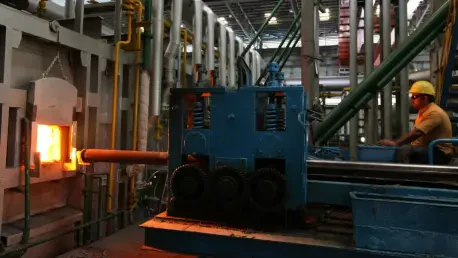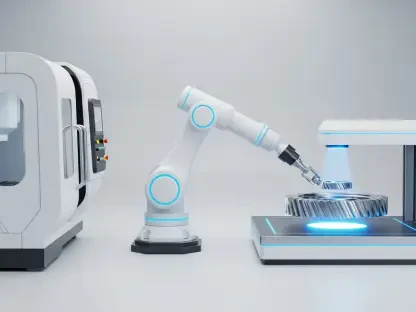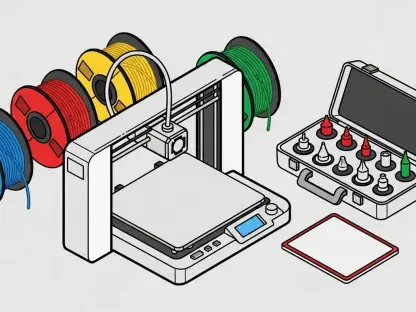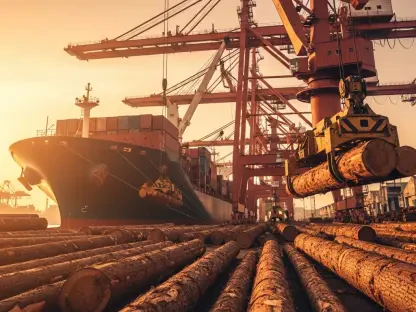The Australian Government’s 2025-26 Federal Budget is poised to significantly reshape the manufacturing sector with substantial investments in clean energy, innovation, and local production. By focusing on sustainable practices and technological advancements, the budget aims to position Australian manufacturing as more competitive and future-ready. This transformative plan is geared towards establishing Australia as a global leader in sustainable and innovative manufacturing, emphasizing long-term growth and environmental responsibility.
Commitment to Green Energy
Sustainable Manufacturing Initiatives
The 2025-26 Federal Budget allocates $19.7 billion towards clean energy and sustainable manufacturing over the next decade. This commitment focuses on areas such as renewable hydrogen, green metals, and clean energy manufacturing. These initiatives are expected to help Australia reduce its carbon emissions significantly, while simultaneously bolstering its position as a global leader in sustainable manufacturing practices. The government’s substantial investment demonstrates a clear ambition to transition the manufacturing sector towards greener and more efficient production methods.
This investment also aligns with global trends towards reducing carbon footprints and embracing environmentally friendly practices. The focus on renewable hydrogen highlights the increasing importance placed on hydrogen as a clean energy source. The government’s ambition to foster a clean energy economy is evident, and the allocation of funds underscores the urgency of these initiatives. The emphasis on green metals further signifies an integrated approach to reducing emissions across various industrial processes.
Expansion of the Clean Energy Finance Corporation
A key element of the budget’s green energy commitment is the $2 billion expansion of the Clean Energy Finance Corporation (CEFC). This expansion aims to leverage an additional $8 billion in private investment, reflecting the government’s strategy to attract private sector participation in the green energy revolution. By extending the CEFC’s capacity, the government intends to accelerate the pace of clean energy projects within the manufacturing sector.
The additional funding for the CEFC is expected to finance a range of initiatives, from large-scale renewable energy projects to smaller, innovative clean energy technologies. This strategic move highlights the importance of public-private partnerships in driving substantial change within the sector. The government’s clear focus on actionable change is echoed by the Industry Minister’s remarks, which underscore the budget as a turning point for sustainable manufacturing in Australia.
Driving Innovation and Technological Advancement
Future Made in Australia Innovation Fund
The government has introduced the $1.5 billion Future Made in Australia Innovation Fund designed to enhance the country’s role in the global pursuit of cleaner industrial processes and stronger supply chains. This fund’s breakdown reveals a strategic allocation: $750 million for green metals, $500 million for clean energy technology manufacturing, and $250 million for low-carbon liquid fuels. By channeling resources into these critical areas, the fund seeks to drive technological innovation and support the development of cutting-edge industrial processes.
These investments are aimed at generating new opportunities within the manufacturing sector, helping Australian businesses to lead in sustainable manufacturing technologies. The fund is also poised to support research and development activities that address the challenges and opportunities presented by the transition to a low-carbon economy. This strategic approach underscores the government’s dedication to fostering a culture of innovation within the sector, ensuring that Australia remains competitive on the global stage.
Enhancing Global Competitiveness
The strategic funding provided by the Future Made in Australia Innovation Fund aims to drive significant technological advancements within the manufacturing sector. This investment not only supports innovation but also strengthens Australia’s global competitiveness by fostering an environment conducive to high-tech, sustainable production methods. By prioritizing green metals, clean energy technology, and low-carbon liquid fuels, the government positions Australian manufacturers at the forefront of the global shift towards sustainable practices.
This focus on technological advancements is essential for maintaining and enhancing Australia’s competitive edge in the international market. The government’s strategic investments provide the necessary support for Australian manufacturers to innovate and adopt new technologies, ensuring their products and processes remain cutting-edge. This forward-looking approach is critical in navigating the evolving demands of the global manufacturing landscape, particularly regarding environmental sustainability and resource efficiency.
Incentivizing Sustainable Practices
Tax Incentives for Growth
The 2025-26 Federal Budget includes several new tax incentives aimed at fostering sustainable practices within the Australian manufacturing sector. Among these is a $2 per kilogram credit for renewable hydrogen production, which is expected to significantly drive the adoption of hydrogen as a clean energy source. Additionally, a 10% incentive on processing and refining costs for critical minerals provides further encouragement for environmentally responsible production practices. These incentives aim to enhance the global competitiveness of Australian manufacturers by reducing the costs associated with sustainable production.
Moreover, a $2 billion Green Aluminium Production Credit has been established to promote the production of sustainable aluminium. These financial incentives are carefully designed to support Australian manufacturers in adopting greener practices without compromising their competitive position in the global market. By lowering the economic barriers to sustainable production, the government hopes to accelerate the transition towards cleaner manufacturing processes across the country.
Encouragement of Environmentally Responsible Practices
The government’s tax incentives are meticulously crafted to encourage environmentally responsible practices among Australian manufacturers. By providing financial rewards for sustainable production methods, these incentives aim to drive innovation and foster growth within the sector. The $2 per kilogram credit for renewable hydrogen production, for example, not only supports the adoption of hydrogen as a clean energy source but also incentivizes manufacturers to invest in the necessary infrastructure and technology.
The introduction of these tax incentives reflects a broader commitment to sustainable economic development. By encouraging manufacturers to prioritize environmentally responsible practices, the government is promoting an industry-wide culture of sustainability. This strategic approach aims to position Australia as a leader in sustainable manufacturing, ensuring that its industrial sector remains competitive while contributing to global efforts to reduce carbon emissions.
Supporting Small and Medium Enterprises
Industry Growth Program
Small and medium enterprises (SMEs) stand to benefit significantly from the 2025-26 Federal Budget through the Industry Growth Program. This initiative is designed to provide SMEs with advisory services and grants to help commercialize innovative products and expand their operations. The program focuses on supporting high-priority sectors, enabling SMEs to play a crucial role in the broader transformation of the manufacturing industry. By assisting smaller manufacturers, the government aims to ensure that growth within the sector is inclusive and widespread.
The Industry Growth Program is geared towards fostering a more innovative and dynamic manufacturing landscape. By providing SMEs with the necessary resources and support, the government is helping these businesses overcome the challenges associated with scaling up and competing in high-priority sectors. This support is vital for the ongoing development of the sector, ensuring that smaller manufacturers can contribute to and benefit from the broader industry transformation.
Promotion of Inclusive Growth
In supporting SMEs, the government is promoting inclusive growth within the manufacturing sector. The Industry Growth Program aims to enable SMEs to contribute to the industry’s future, ensuring that the benefits of the budget’s investments are spread across businesses of all sizes. This inclusive approach is essential for fostering a diverse and resilient manufacturing ecosystem, where smaller enterprises can thrive alongside larger corporations.
By encouraging the growth and development of SMEs, the government is helping to create a more balanced and dynamic manufacturing sector. Inclusive growth ensures that innovation and technological advancements are not confined to larger companies but are accessible to businesses of all sizes. This strategy is critical for building a robust and sustainable manufacturing industry that can adapt to future challenges and seize new opportunities.
Workforce Reforms and Flexibility
Improving Talent Mobility
The 2025-26 Federal Budget introduces several workforce reforms aimed at fostering a more competitive labor market. One notable reform is the ban on non-compete clauses for workers earning below $175,000 annually. This change is expected to enhance worker mobility, allowing skilled employees to transition between employers more freely. By promoting greater knowledge-sharing and collaboration within the industry, these reforms are likely to drive innovation and potentially lead to wage growth within the manufacturing sector.
The government’s workforce reforms aim to create a more dynamic and flexible labor market, where talent can move freely to where it is most needed. This flexibility is crucial for fostering a culture of innovation and continuous improvement within the manufacturing sector. By removing barriers to worker mobility, the government is encouraging the spread of best practices and new ideas, contributing to the overall growth and development of the industry.
Fostering a Dynamic Workforce
In addition to improving talent mobility, the government’s workforce reforms are designed to cultivate a more dynamic and innovative workforce. By allowing skilled workers greater freedom to transition between employers, the reforms encourage the continuous exchange of knowledge and expertise. This is vital for driving innovation and addressing the evolving needs of the manufacturing sector. The government recognizes that a flexible and responsive workforce is essential for maintaining the industry’s competitiveness and ability to adapt to future challenges.
Efforts to foster a dynamic workforce also include initiatives to support training and workforce development. By investing in skills development, the government aims to ensure that the manufacturing sector has access to a highly skilled labor pool capable of driving the industry forward. These reforms are crucial for addressing potential skill shortages and ensuring that the sector can meet the demands of a rapidly changing global market.
Emphasizing Domestic Production
Buy Australian Initiative
The 2025-26 Federal Budget allocates $20 million towards the Buy Australian initiative, which is designed to promote locally made products. By encouraging businesses and consumers to prioritize Australian-made goods, the initiative aims to boost domestic production and stimulate consumer demand for locally manufactured products. This focus on domestic production is intended to reinforce the role of manufacturing within the national economy and contribute to the sector’s stability and growth.
Promoting locally made products not only supports Australian manufacturers but also benefits the broader economy. By encouraging the purchase of Australian-made goods, the Buy Australian initiative aims to strengthen the domestic market and reduce reliance on imported products. This strategy is particularly important in the context of global supply chain disruptions, as it enhances the resilience and self-sufficiency of the national economy.
Boosting Consumer Demand
The Buy Australian initiative is designed to stimulate consumer demand for locally manufactured products. By highlighting the quality and reliability of Australian-made goods, the initiative aims to persuade both businesses and consumers to choose domestic products over imported alternatives. This increased demand is expected to provide a significant boost to the manufacturing sector, supporting growth and job creation.
The initiative also aligns with broader efforts to promote sustainability and reduce the environmental impact of long-distance shipping. By prioritizing locally made products, the government is encouraging more sustainable consumption patterns. This dual focus on supporting domestic manufacturing and promoting environmental responsibility reflects an integrated approach to economic development and sustainability.
Key Takeaways
The Australian Government’s 2025-26 Federal Budget is set to significantly transform the country’s manufacturing sector through substantial investments in clean energy, innovation, and local production. By prioritizing sustainable practices and technological advancements, the budget intends to make Australian manufacturing more competitive and ready for the future. This transformative strategy aims to establish Australia as a global leader in sustainable and innovative manufacturing, focusing on long-term growth and environmental responsibility. Emphasizing renewable energy sources and cutting-edge technology will not only reduce the carbon footprint but also enhance efficiency and productivity within the sector. The government’s commitment to these initiatives underscores their dedication to building a resilient and forward-thinking manufacturing industry. With a clear vision for the future, the budget supports initiatives designed to drive economic stability and environmental stewardship, ensuring that Australia’s manufacturing sector thrives in the global market while adhering to the principles of sustainability and innovation.









